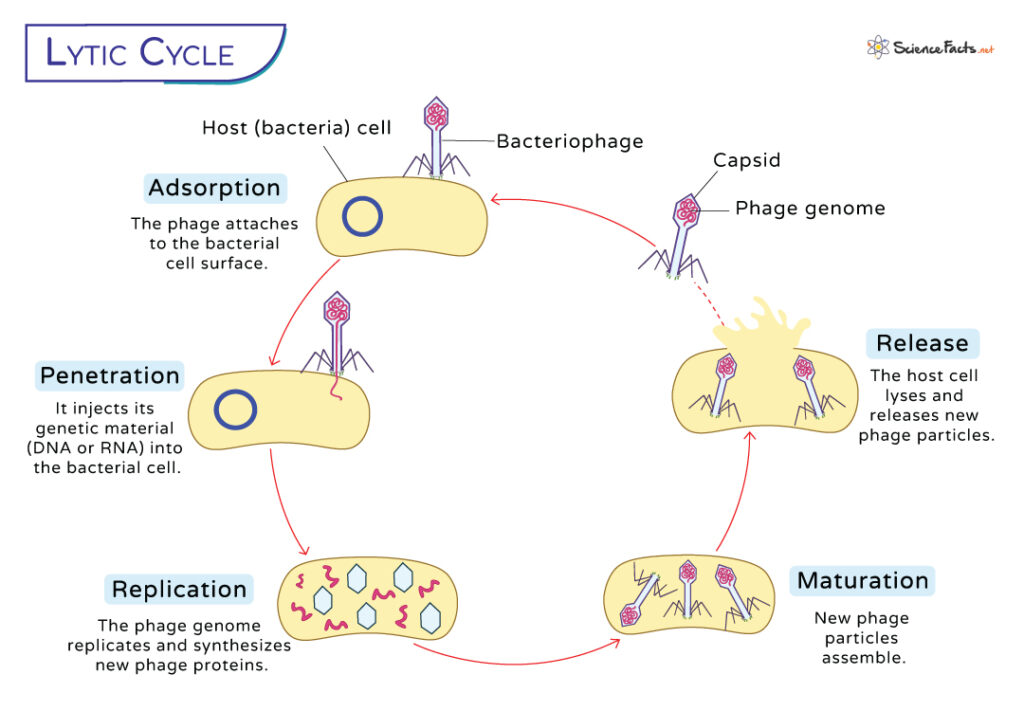Lytic Cycle
The lifecycle accomplished by the virulent phages for their reproduction is called the lytic cycle. During the lytic cycle, the virus takes total control over the cell, reproduces new phages, and then destroys the infected cell and its membrane, releasing the virus particles. Here, the viral DNA exists as a separate entity within the host cell and replicates separately, which is its main difference from the lysogenic cycle.
T4 bacteriophage is an example of a lytic phage infecting the bacterium E. coli found in the human intestinal tract. Lytic phages are useful for phage therapy.
Steps of the Lytic Cycle
There are five stages in the lytic cycle of a virulent phage:
1. Adsorption
It is the first phase of the lytic cycle, which involves the attachment of the bacteriophage to the bacterial cell surface. The phage’s tail fibers and other surface proteins recognize and bind to particular receptors on the bacterial cell wall.
The interaction between the phage and the bacterium is particular. Once a phage has successfully adsorbed to a bacterial cell, it often prevents other phages from infecting the same cell, a phenomenon known as superinfection exclusion.
2. Penetration
After successfully attaching the phage to the bacterium, it injects its genetic material (DNA or RNA) into the bacterial cell. This injection is facilitated by the contraction of the phage’s tail sheath. Like a coiled spring, the sheath contracts and then drives the tube into the host cell on release of the genetic material.
The injected viral genetic material takes command of the host cell’s machinery. It marks the beginning of a shift in cellular activities from normal bacterial functions to the production of viral components.
3. Replication
The replicated viral genetic material now serves as a template for synthesizing new phage components. The host cell’s ribosomes, enzymes, and other cellular machinery are hijacked to produce viral DNA or RNA, proteins, and other parts.
The phage synthesizes early proteins, including endonucleases and exonucleases that degrade the host DNA. They then take over total control of the host cell machinery to synthesize proteins that make up the phage particles.
The newly synthesized viral components combine within the host cell to form complete phage particles. This assembly process occurs in a coordinated manner, with precise coordination of viral protein and nucleic acid synthesis.
The biosynthesis involves three phases:
- Early Phase: During this phase, the host cell enzymes modify the host transcription through RNA polymerase. It is achieved by adjusting the sigma factor of the host RNA polymerase.
- Middle Phase: It is the phase where nucleic acid (DNA or RNA) is synthesized.
- Late Phase: Structural proteins, including the head and tail proteins, are synthesized during this phase.
4. Maturation
The newly synthesized phage genome is then encapsulated within the phage particles. This packaging ensures that the genetic material is protected during the next steps of the viral life cycle.
Maturation involves the final steps of assembling functional phage particles, which then become ready for release. These particles contain the genetic information required for initiating infection in new host cells.
5. Release
The host cell, filled with replicated phage particles, finally undergoes lysis, causing death. The mature phage particles are thus released inside the host. A single bacterium on lysis releases 50 to 200 phages. This release is often a violent process where the bacterial cell membrane is compromised, and the new phage particles are released into the surrounding environment. The released phages are now free to infect new bacterial cells, continuing the infectious cycle.
Thus, to summarize the lytic cycle, it is a biological process used by bacteriophages to exploit the host cells for their reproduction.
-
References
Article was last reviewed on Thursday, December 7, 2023




